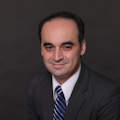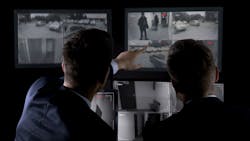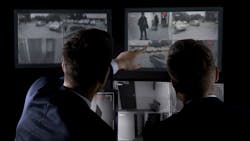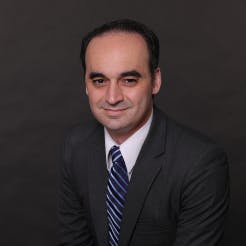Audio becoming part of the security systems plan
Let’s be honest. Part of your security system could be 100 years out of date. Because if your video system is missing audio, then it’s as modern as a silent Charlie Chaplin film.
It’s well known that the security industry is thorough in its vetting of innovative technologies before fully adopting and deploying them into the mainstream. But audio isn’t new, and it’s already mainstream. Indeed, its absence from many video systems is noticed by consumers who expect all electronics with video to also have audio, not just as an option, but by default.
Many in our industry hold maintain long-held concerns about using audio in ways that comply with federal and state laws and regulations. Security architects and installers are vexed with the dilemma of rising consumer demand for audio coupled with a heretofore lack of guidelines or best practices on the proper ways to use sound. Fortunately, there are now answers available from both the security industry and others.New Guidance on the Use of Audio
In an upcoming Security Industry Association (SIA) paper, SIA’s Audio & Intelligent Communications Working Group will outline the best practices for sound in security systems, informed by subject matter experts within the industry. Association members will have a guide for managing privacy expectations against consumer demand and the additional benefit that sound provides over silent video. The paper will also layout the business case for using audio with video, and how integrators can increase their topline revenues much faster with audio than they can with additional video technologies.
We can also look to other industries for guidance on recording audio. Everyone has experienced making a call to a customer service center and being greeted not by a human voice, but by a recording notifying us that this call is recorded for training purposes and for quality control. No one questions the permissibility of recording audio in this instance. The same is true of TV reporters interviewing a person on the street about current events, sports, or a topic of local interest. In this case, an external microphone is attached to a video camera and recorded.
Open up the camera on any smartphone from the past fifteen years and start recording video. The phone will start recording audio in sync with the video, automatically. In recent years we have seen the prevalence and relevance of cell phone recordings being used for security and investigative purposes, including establishing the context of a situation and as evidence in prosecutions and defenses. Think of all the public protests, riots, demonstrations, and marches seen on TV in just the past two years. Most of these events are recorded using cell phones, and those recordings include audio. The people doing the recording are not accused of, much less charged with unlawful audio recording, eavesdropping, or wiretapping, but their recordings are used as evidence against those who are destroying property, committing assaults, or otherwise engaging in illegal activity.
Security Audio Can Be a Forensic Tool
Moreover, judges across the United States regularly admit audio recordings into evidence. An online search for news reports and articles for “audio evidence” or “audio recordings” will yield countless examples of courts allowing audio recordings to be used in prosecuting criminal cases. Recent cases include establishing probable cause in a South Dakota homicide investigation, prosecuting a public corruption case in Nebraska, or going even further as a California judge did in ordering the release of audio recordings related to investigations of the 2021 Dixie Fire.
Not only are judges admitting audio into evidence, but many courthouses also use audio as part of their own security systems and use the recordings to investigate incidents in the courtroom. Just in the past few months, audio recordings were used to determine what happened leading up to an altercation between a court deputy and a public defender in a Rochester, New York court. There is no video of the incident. In Virginia, audio was key to a contempt investigation after a judge suspected a witness of testifying while under the influence.
Audio and the Law
So, the question then is not whether or not audio can be used with video, but instead one of where and how. The security industry is now taking a fresh look at how to be sure that installations of audio with video do not violate privacy expectations.
If you were to ask a group of people what constitutes an expectation of privacy, each person would give a slightly different answer. Fortunately, a long-standing framework exists to ensure that privacy expectations are not violated by the use of security equipment.
In 1967 the US Supreme Court issued a landmark ruling in the case Katz v United States. A man named Charles Katz had been arrested and convicted of violating the Wire Act of 1961 for transmitting information on sports betting over state lines. To obtain evidence against him, the FBI had placed listening devices on the outside of a phone booth that they suspected Katz of using – notably not using a warrant to do so. Upon the eventual appeal to the Supreme Court, attorneys argued that because the FBI did not have a warrant, that the evidence against Katz was obtained by an unreasonable search.
In the majority opinion, Justice Potter Stewart helped define what information is and is not subject to privacy protections, writing, …the Fourth Amendment protects people, not places. What a person knowingly exposes to the public, even in his own home or office, is not a subject of Fourth Amendment protection. But what he seeks to preserve as private, even in an area accessible to the public, may be constitutionally protected.
In a concurring opinion, Justice John Marshall Harlan II wrote further, establishing a two-part test to determine whether an expectation of privacy exists. Known as the Katz Test, it reviews 1) first that a person has exhibited an actual (subjective) expectation of privacy, and 2) the expectation be one that society is prepared to recognize as "reasonable."
Justice Harlan II further explained, Thus a man's home is, for most purposes, a place where he expects privacy, but objects, activities, or statements that he exposes to the "plain view" of outsiders are not "protected" because no intention to keep them to himself has been exhibited. On the other hand, conversations in the open would not be protected against being overheard, for the expectation of privacy under the circumstances would be unreasonable.
In the present day, while providing notification of audio recording in use may not be required to remove the expectation of privacy or to obtain implied consent, industry best practices dictate that notification of audio recording ought to always be provided not only for compliance purposes but also as a courtesy to those being recorded.
For purposes of audio recording in security systems, there are two principal types of consent – express consent and implied consent. Express consent is directly communicated verbally or in writing. It is a statement agreeing with the terms of the recording. In the above example, express consent would be given with the statement “I agree that this call can be recorded.” Implied consent is given through actions and behaviors that demonstrate a person’s agreement with the recording notwithstanding any spoken or written agreement. Staying on the phone after the representative informs you that the call is recorded is implied consent.
The privacy framework established in Katz v United States is the basis for the widespread use of audio technologies in use today. When designing security systems, consider if audio is picked up in areas considered to be in public or in plain view and if the environment is one which people generally consider to be private. Furthermore, use tools such as entry signage, written memos, or other methods of disclosure to make it clear that audio is used on-site as part of the security system.
There is no shortage of examples of audio being used with video across technology fields. By understanding how to include sound in security systems, our industry can offer more robust and capable systems, while also ensuring the fundamental values our society places on privacy.
His work in the industry spans North and South America. In 2015 Javdani received the President’s E Award for Export Achievement from the US Department of Commerce in recognition of long-term success in exporting American-made products to international markets. Throughout his career, Javdani has focused on long-term growth strategies building strategic partnerships with key distributors, integrators, and end-users. Javdani is actively involved with the Security Industry Association and is a contributing member of the Women In Security Forum, including serving on the fundraising committee for their inaugural 2020 scholarship program.
About the Author

Cameron Javdani
President at SoundSecure
Cameron Javdani is President of SoundSecure, a provider of audio technologies specifically for the security industry. https://sound-secure.com


